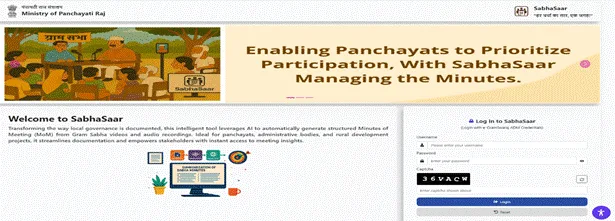Sabhasaar
Sabhasaar is India’s pioneering AI tool for digitizing Panchayat and Gram Sabha records—offering multilingual, real-time meeting documentation, reducing errors, building transparency, and supporting inclusive rural governance.

Why is it in News?
The Ministry of Panchayati Raj recently launched “Sabhasaar,” an innovative Artificial Intelligence (AI) tool that transforms the way gram sabha and panchayat meetings are documented. This marks a major milestone in India’s digital governance efforts, bringing advanced technology to the grassroots level. Through “Sabhasaar,” traditional handwritten records are replaced by real-time digital documentation, ensuring greater transparency and accountability in local self-government.
Purpose and Significance
Sabhasaar is designed to strengthen India’s three-tier Panchayati Raj system by overcoming longstanding issues in manual record keeping. Historically, recording the minutes of village meetings has been a complex and error-prone process, often relying on overworked clerks and limited resources. The introduction of an AI-based tool addresses these challenges head-on.
Its significance is amplified by its ability to process discussions in diverse local languages—a crucial step for India’s multilingual rural landscape. Sabhasaar promotes inclusivity by capturing the voices of women and marginalized community members, whose contributions might otherwise go unrecorded.
By automating and digitizing meeting minutes, Sabhasaar reduces errors, saves time, and improves the overall quality of governance. Most importantly, it promotes transparency in decision-making and helps curb corruption at the local government level.
Important Information
- Sabhasaar utilizes advanced technologies like Natural Language Processing (NLP) and Speech Recognition to record, transcribe, and organize meeting proceedings in real time.
- It supports multiple Indian languages along with English, ensuring nationwide accessibility.
- The tool recognizes speakers, accurately attributing statements to individual participants and facilitating clear records of discussions and decisions.
- Robust data security protocols are in place: all recordings and data are encrypted and accessible only to authorized personnel.
- As a cloud-based solution, Sabhasaar allows remote access and storage, enabling panchayats even in the most isolated regions to benefit from digital governance.
- Automated report generation compiles the main discussion points, decisions made, and follow-up actions immediately after the meeting.
Fact Table
| Aspect | Details |
|---|---|
| Launch Ministry | Ministry of Panchayati Raj |
| Tool Name | Sabhasaar |
| Core Technology | Artificial Intelligence (AI), NLP, Speech Recognition |
| Key Function | Real-time digital documentation of gram sabha meetings |
| Language Support | Multilingual: Indian languages + English |
| Target Users | Panchayat members, clerks, villagers |
| Data Security | Encrypted storage; authorized access only |
| Platform | Cloud-based for nationwide reach |
| Additional Feature | Automated report generation |
Conclusion
The launch of Sabhasaar is a landmark for rural governance in India, highlighting the power of technology in strengthening democracy at the grassroots. By improving record-keeping, reducing errors, and boosting transparency, this tool helps panchayats function more efficiently and fairly.
Sabhasaar supports social justice and women’s empowerment by ensuring all voices are counted and documented. Its deployment advances the goals of “Digital India,” making local government smarter and more inclusive.
Proper implementation will accelerate rural development, improve service delivery, and foster better civic participation. Sabhasaar’s success will set a precedent for bringing cutting-edge solutions to rural India and inform future digital governance policies.
Key Facts
- Launched by Ministry of Panchayati Raj (August 2025)
- Automates minutes of Gram Sabha and Panchayat meetings (audio/video to text)
- Integrates Bhashini, the National Language Translation Mission
- Supports 13 Indian languages (with future expansion planned)
- Used for 1,194 Gram Panchayats in Tripura; urged nationwide adoption
- Enables speaker identification, decision tracking, summary reporting
- All data encrypted and cloud-based; authorized access only
- Reduces manual workload, boosts accuracy and accountability
- Promotes women’s empowerment by documenting all voices
- Model for participatory democracy and “Digital India” initiative
UPSC Practice Questions
- Evaluate the role of digital innovation in transforming India’s Panchayati Raj Institutions. Illustrate with examples like Sabhasaar.
- Discuss the challenges and opportunities in digitizing local governance in rural India.
- Analyze how technology-enhanced documentation can improve transparency and accountability at the grassroots level.
- Suggest measures to overcome the “digital divide” for successful implementation of tech-based solutions in villages.
